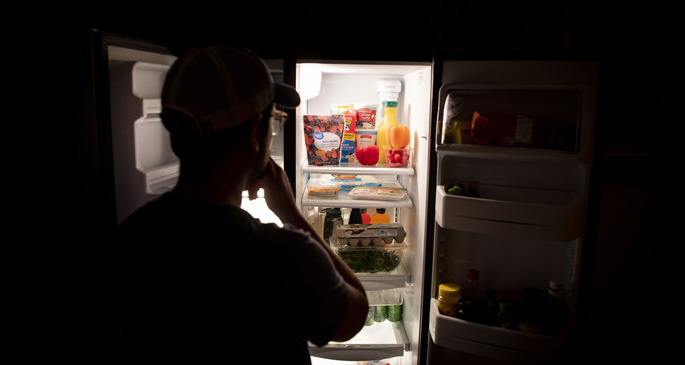
by Nancy Humphrey
Social distancing during the COVID-19 pandemic could keep many people at home for weeks with fewer trips to the grocery, so it’s natural to want to eat what’s in your freezer or pantry.
A Vanderbilt University Medical Center nutritionist offered some sound advice during this time — watch your sodium and sugar intake, and your calories.
Fran Blackman, RD, CDE, LDN, a nutritionist who specializes in patients with diabetes and cardiovascular diseases and those undergoing weight management, said eating fresh and less processed foods is always better, but if you’re limiting your grocery trips and are concentrating on eating what’s in your freezer and pantry, make sure you’re getting enough protein, you’re not snacking or grazing excessively and watching both your calorie and sodium intake.
“I always encourage people to focus on protein balance with some carbohydrates,” she said. “If you need a snack, instead of grabbing a bag of potato chips, how about peanut butter and crackers or cheese and crackers? And if you choose potato chips, how about a serving of tortilla chips? They have whole corn and a little more fiber than a potato chip.”
For breakfast, cereal is OK every now and then, but how about toast with peanut butter and a boiled egg? Something that’s a little more balanced and isn’t just carbohydrates.”
For those with hypertension, or for those just watching their sodium, Blackman offered the following tips.
- Choose frozen vegetables over canned.
- If you buy canned vegetables, choose no sodium added.
- For recipes that call for chicken broth, choose the low sodium version; if you can’t find the low sodium version at your grocery, use half the amount of regular broth and add an equal amount of water.
- For tuna, choose the low sodium variety. For a healthy, quick meal, combine low sodium tuna with noodles and add some frozen broccoli.
- If you like cheese, be careful with portions; and choose Swiss cheese over other varieties — it has about one-third of the sodium of other cheeses.
- Adults should aim for less than 2,400 mg. of sodium a day. If you are eyeing labels when you buy something at the grocery, a general rule is that anything 300 mg. and over per serving is “kind of a red flag,” Blackman said.
- Foods under 140 mg. of sodium per serving are considered low sodium.
- A good rule of thumb is to aim for not more than about 600 mg. of sodium per meal. If you’ve chosen a frozen meal, for example, choose one that doesn’t exceed 600 mg. of sodium and pair it with a piece of fruit, cooked frozen vegetables or a salad, if available.
Blackman said it’s also important to remember that comfort foods, which people turn to when they’re stressed, tend to be high in fat and sugar. “The more sugar you eat, the more sugar you crave,” she said.
She offered these tips for limiting sugar in your diet:
- Instead of a sugary snack, eat a piece of fresh fruit, or a fruit cup packed in its own juice.
- Watch your beverages. They can add a lot of sugar and calories to your daily calorie count. Look at the sugar content in your beverages. Instead of a full-calorie sodas and juices, choose a diet version. If you’re a sweet iced tea drinker, blend your sweetened version with unsweetened to cut down on sugar. Better yet, drink water.
- For breakfast, avoid croissants, doughnuts or pastries. Try a piece of toast with peanut butter; Greek yogurt and fruit; or apple with peanut butter instead.












